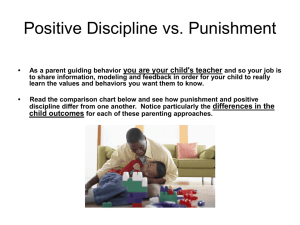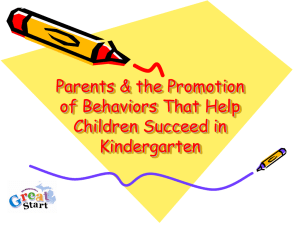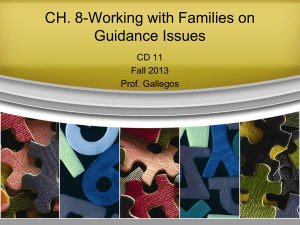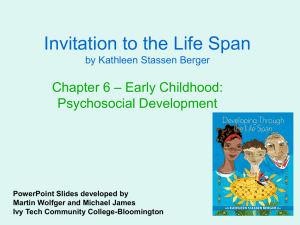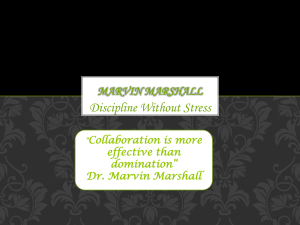Characteristics of Effective parenting styles (Baumrind)
advertisement
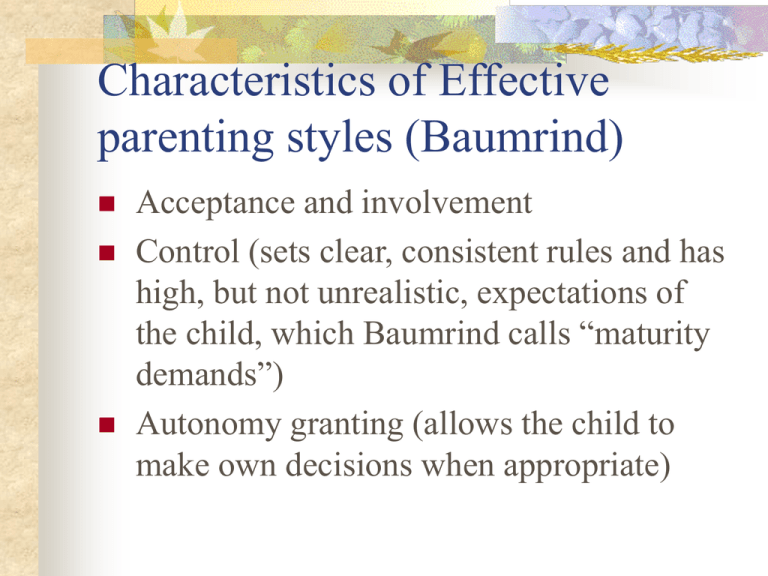
Characteristics of Effective parenting styles (Baumrind) Acceptance and involvement Control (sets clear, consistent rules and has high, but not unrealistic, expectations of the child, which Baumrind calls “maturity demands”) Autonomy granting (allows the child to make own decisions when appropriate) Authoritative parenting The most effective child-rearing style High in acceptance and involvement Exercise firm, reasonable control and insist on mature behavior (and give reasons for expectations) Parents are warm, attentive, sensitive to needs Create an emotionally fulfilling bond with child Grant child autonomy to make decisions when he’s ready to do so Traits of children from authoritative parenting High in self-esteem Independent Altruistic and cooperative Self-confident Achievement-oriented; persist at tasks Academically successful Upbeat mood Authoritarian parenting style Low in warmth, acceptance, and involvement High in control, physical punishment, and psychological coercion (e.g., withdrawing love). Critical and threatening Make decisions for child and expect the child to accept them without question; don’t allow much autonomy Cold and rejecting Traits of children from authoritarian parenting Anxious, unhappy, low self-esteem React with hostility when frustrated Boys, especially, show high rates of anger and defiance; aggression likely Girls are likely to be dependent and overwhelmed by challenging tasks Do poorer in school and have fewer social skills with peers Permissive parenting style Warm and accepting but uninvolved Parent has low “maturity demands” – don’t expect much from the child May be overindulgent or lax with rules and discipline Try to be “friends” with the child, rather than their parent Let child make most decisions and engage in little control of the child (e.g., child can go to bed when he wants to, doesn’t have to behave, etc.) Traits of children from permissive parenting Impulsive, disobedient, and rebellious Overly demanding and dependent on adults Show less persistence on tasks Link between permissive parenting and overly dependent, nonachieving behavior is especially strong for boys Do worse in school, especially during adolescence Likely to be immature with peers and in school Unlikely to be independent or take responsibility Uninvolved parenting style Considered to be the worst style Low acceptance and involvement Little or no control of child General indifference to autonomy granting Parents are emotionally detached, overwhelmed, & depressed—no time or energy for children Can lead to neglect of child Traits of children from uninvolved parenting Disrupts virtually every aspect of development, including attachment, cognition, and emotional & social skills Poor emotional self-regulation School achievement difficulties Antisocial behavior Impulsive, incompetent with peers; show disturbances in social relationships for many years Cultural variations Chinese parents describe their parenting as more controlling; they’re more directive in teaching & scheduling children’s time; foster high selfcontrol and achievement Chinese parents appear less warm than Western parents but really aren’t. Hispanic—insist on respect for parents, especially father, but show high parental warmth. African-American parenting styles Wide variations here, but among low SES African-American groups, the following traits are often seen: Expect immediate obedience Are very strict as a way of fostering self-control and a watchful attitude in risky environments Use a “no-nonsense” discipline combining strictness, physical punishment, and warmth & reasoning The goal of discipline Discipline is not synonymous with punishment The goal of discipline is to correct unwanted behavior and teach the child more appropriate ways to behave The ultimate goal is the development of morality in the child Discipline methods are widely controversial. Inductive discipline Induction: when an adult helps the child notice feelings by pointing out the effects of the child’s misbehavior on others. Helps establish empathy in the child and is effective starting around age 2 Preschoolers whose parents use it are more likely to refrain from wrongdoing, confess and repair damages after misbehavior, and display helping behavior. More about induction Helps child develop ideas about morality by inducing empathy for others Gives children reasons for changing behavior that make sense to them Inducing empathy-based guilt is an important motivator of moral action. Discipline that relies on punishment or threats of it When you threaten punishment, engage in harsh physical punishment, or threaten to withdraw love, children become so anxious and afraid that they can’t think clearly enough to figure out what they should do. These practices do NOT get children to internalize moral rules. Long-lasting effects of harsh discipline The more harsh threats, angry physical control, & punishment that kids experience, the more likely they are to develop serious, lasting mental health problems. Weak internalization of moral rules Depression Aggression, antisocial behavior Poor academic performance Criminality and partner & child abuse in adulthood What do children learn from harsh discipline? Parents often spank in response to children’s aggression, but spanking itself is an aggressive act. Children develop a chronic sense of being personally threatened, which prevents empathy toward others. More focused on self-protection. Children who are spanked are much more likely to spank their own children. Prevalence of spanking in America Between 70-90% of American adults report spanking their children. Spanking is most prevalent in the preschool years—peaks around age 4 and then starts declining at age 5. 50% of parents still spank children at age 12. Is spanking ever good? A recent meta-analysis of many over 20 studies show that mild corporal punishment is actually one of the most effective methods of punishment (compared with other techniques such as time-out and withdrawal of privileges). Spanking needs to be MILD, done with the hand only, accompanied by explanations of the wrongdoing, and not done in anger to be effective. Most child experts disagree with spanking entirely. Cultural differences in spanking Among Caucasian-Americans, physical punishment is positively associated with adolescent aggression and antisocial behavior. In African-American families, the opposite is true: the more mothers had disciplined physically in childhood, the less their teenagers displayed angry, acting-out behavior and got in trouble at school and with police. Why the cultural differences? In Black families, physical discipline is culturally approved, generally mild, delivered in a context of parental warmth, and aimed at helping kids become responsible adults. White parents usually consider physical punishment to be wrong, so when they resort to it, they’re usually agitated and rejecting the child. Black children may view spanking as done with their best interests in mind, and White children view it as an act of personal aggression. Alternatives to physical punishment Put the child in time-out until he’s ready to act appropriately. Withdraw privileges (works especially well with an older child) Use “positive discipline” Positive discipline Build a mutually respectful bond with the child Let the child know ahead of time how to act— what the rules are Praise mature behavior Children show firmer conscience development and express empathy after transgressions, play fairly in games, and behave responsibly and kindly. If child genuinely loves and respects the parent, she’ll want to heed parental demands. Three cardinal rules for discipline Consistency—don’t permit children to misbehave on some occasions but scold them on others. Warmth—a warm parent-child relationship makes the child find parental displeasure especially upsetting. They want to regain parental warmth and approval as soon as possible. Explanations—Tell the child what he did wrong and why he’s being punished; leads to much bigger reduction in misbehavior than punishment alone. The importance of modeling Children learn to behave morally largely through modeling—watching and imitating people who demonstrate appropriate behavior. Models are most influential during the preschool years. Children who have had consistent exposure to caring adults have internalized prosocial rules and follow them regardless of whether the model is present. Child Abuse: Statistics Especially common in large industrialized nations In U.S., 12 out of every 1000 children were identified as child abuse victims in 2005; the actual number is thought to be MUCH higher. Parents commit more than 80% of the abusive incidents; other relatives account for 7%. Remainder are from parents’ unmarried partners, school officials, camp counselors, etc. Mothers engage in neglect more than fathers; fathers engage in sexual abuse more than mothers. Types of child abuse Physical abuse Sexual abuse (most common in middle childhood) Neglect (most common in infancy an young preschool years) Emotional abuse Preschool and school-age children are most likely to receive physical, sexual, and emotional abuse. Is there an “abusive personality type”? Child abuse is more common in “disturbed” (mentally ill) parents, but there is no single abusive personality type. Even “normal” parents sometimes abuse their children. Parents who were abused as children do not necessarily become abusers. The abuse-prone child Premature or very sick babies are more likely to be abused. Temperamentally difficult children Attention-deficit and hyperactive children Children with other developmental problems Parents who are likely to abuse Alcohol and drug abuse Psychological disturbance History of abuse as child Belief in harsh physical discipline Unreasonable expectations for child Young parents (under 30) Low educational level Family characteristics of abuse Low income; poverty; homelessness Marital instability Social isolation Physical abuse of mother by husband or boyfriend Frequent moves Large families or closely-spaced children Overcrowded, disorganized households Unemployment or other types of stress Consequences of child abuse Impairs the development of emotional selfregulation Inhibits empathy and sympathy development Poor self-concept Lack of social skills and academic motivation Severe depression, aggression, peer difficulties, substance abuse, and delinquency (including violent crime) Further consequences Demeaning parental messages result in Low self-esteem, self-blame High anxiety Difficulty forming close relationships Depression and suicide attempts Serious behavior problems in school Central nervous system damage (abnormal EEG; reduced size and impaired functioning of the cerebral cortex and corpus callosum; heightened production of stress hormones Preventing child abuse Providing social support to families is crucial Single most important factor in preventing mothers with a childhood history of abuse from abusing their own children is having a trusting relationship with another person—can be a spouse, friend, or family member. 1500 American children, mostly infants and preschoolers, die from child abuse every year.
